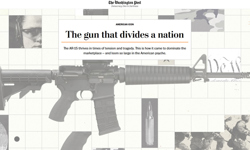The method by which information is gathered and reported is constantly challenging traditional and broadcast journalism, the two main pillars of this great profession.
Journalism faces many questions these days like, how should news be gathered and reported? Who can gather news? Who can report news? Is journalism beyond the stereotype of an individual sitting at a desk with a jug of coffee typing ferociously onto an Apple Mac to meet their editor’s deadline?
Walter Lippmann argued in the 1920s that the role of journalism was to act as a 'mediator or translator between the public and policy making elites' - which effectively meant the journalist would listen to the elite, digress the information they passed out, and communicate it better to the public in much simpler terms. This view made consumers of news seem incapable of any analytical approach to news and instead gave the assumption that the public should be given simple information.
The alternative argument was made by John Devey, who basically wanted journalists to engage citizens when generating any type of content because he thought they were much more intelligent.
So where is journalism today? We are now spending more time consuming news then we used to, because we have three mediums to inform us of events: traditional media (newspapers and magazines), 24 hour broadcast media (news channels like CNN and the BBC) and finally, online media. The last of these has changed the way news is consumed.
During the first Gulf War in 1991, CNN revolutionised the news industry by introducing a 24 hour news outlet that left newspapers and other daily bulletins in their wake. How could anyone compete with a channel that was constantly feeding news through one channel, every minute of every day? Often, newspaper editors would sit watching CNN all day to help them decide what tomorrow's headlines would be. Now, we have many 24 news channels so the sphere is pretty much level pegging.
However, online news has changed everything again, because newspapers could update their stories online, meaning they could constantly challenge news channels because not only would they provide an analytical viewpoint of events, they would have journalists embedded in areas where news camera crews would face heavy opposition. One only has to go back to Iran's ban on the BBC news team or Al Jazeera's failure to report in certain Arab states to see the challenges faced by 24 hour news crews. Traditional journalism has caught up with broadcast media but 24 hour news is still a strong phenomenon that takes a larger audience share.
Many would argue that reporting hasn't changed and will not change as the role of the reporter is as important as ever with ever-changing global events. The reporter will always stay impartial, report all the facts and provide a detailed analysis of the events. But news gathering has changed dramatically. Paul Bradshaw (who blogs at www.onlinejournalismblog.com) calls this 'the rise of the amateur', more commonly known as the citizen journalist. There is little doubt about the enormous value of audience-provided information.
The way news is reported is enhanced greatly by user-generated content because those people are at the forefront of the news, and not hidden away in a big office thousands of miles away waiting for wire updates. The first instance of this type of amateur reporting came about after the events of 9/11 when individuals would blog about the events they had witnessed. Many of the first images emerging from the New York attacks were from mobile phone videos captured by onlookers. During the tragic Boxing Day Tsunami in South East Asia, most news outlets would desperately search for camcorder video recordings and photos from stranded tourists. Slowly, the spread of blogs, smartphone imagery and UGC made journalists from both traditional and broadcast media realise one thing - the consumer of news was now the provider of news.
I believe the recent events of the Arab Spring, the revolutions in Egypt, Libya and Tunisia, have shown how collating information and news from the citizen on the street is the most important way of gathering news because they are the ones that actually show us what is happening on the streets, what is occurring in those countries. Now, more than ever, news gatherers have to realise the importance of making use of on-location sources. But it is not as simple as just identifying these people on the 'street'. New media has provided a platform for citizens on the street to actually break news themselves - a concept Blottr has taken on itself, which allows citizens to upload their own news and report the news.
Therefore, traditional media and broadcast media are slowly realising that the role of the citizen journalist is much more important than it was ten years ago. We all love eyewitness accounts to help us clarify a story but the advancement of technology and new media has enabled the citizen to be more than capable of reporting news themselves. Smartphones give you the opportunity to take hi res images and record good quality videos. New media allows you to spread the word quicker than any 24 news channel once thought it could do.
The online audience is much bigger than those offline, and news gatherers are now facing key questions about how they get information to broadcast to their audiences.










